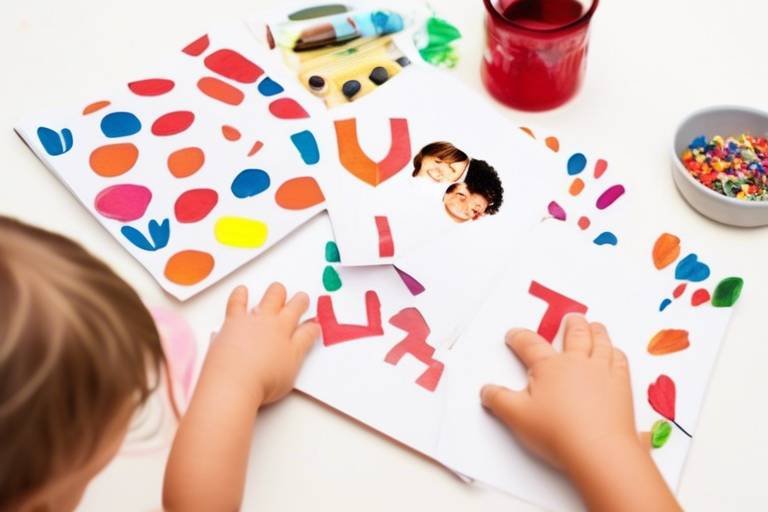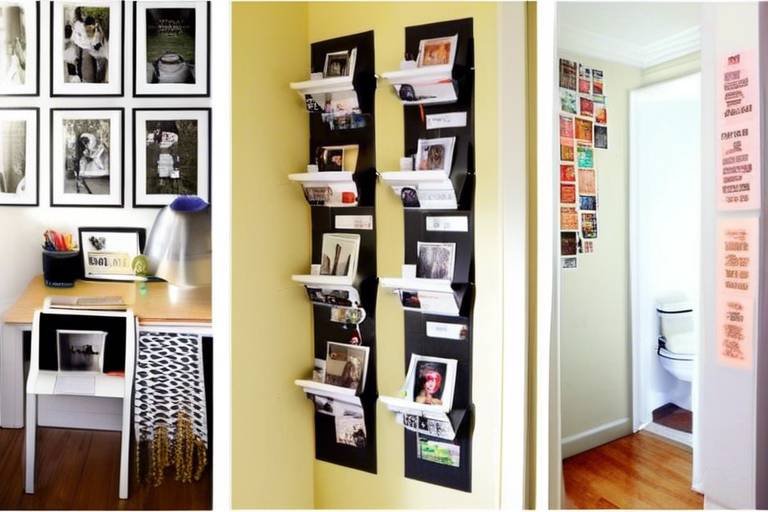How to Create a DIY Plant Terrarium for Kids
Are you looking for a creative and educational activity to engage your kids with nature? Creating a DIY plant terrarium is a fantastic way to introduce them to the world of plants and ecosystems. Not only is it a fun project, but it also teaches children about responsibility and the importance of caring for living things.
So, how can you start this exciting journey of building a miniature garden in a glass container? Let's dive into the step-by-step guide on how to create a DIY plant terrarium that will captivate your kids' imagination and nurture their love for nature.
First and foremost, gather all the necessary supplies to ensure a smooth terrarium-making experience. You will need a glass container, potting soil, small plants (such as succulents or air plants), decorative elements like colorful stones or miniature figurines, as well as tools for planting and arranging the terrarium components.
When selecting plants for your terrarium, opt for varieties that are easy to care for and thrive in a closed environment. Succulents, air plants, and small ferns are excellent choices that require minimal maintenance and can withstand the conditions inside a terrarium.
To enhance the visual appeal of the terrarium, consider adding decorative elements that reflect your kids' creativity and personal style. Encourage them to choose colorful stones, tiny figurines, or even small toys to make their terrarium unique and special.
Now comes the exciting part of layering the terrarium components. Start with a layer of gravel or pebbles at the bottom for drainage, followed by activated charcoal to keep odors at bay, and then add a layer of potting soil for the plants to grow in. Explain to your kids the importance of each layer in creating a healthy environment for the plants.
Once the layers are in place, guide your children in planting the selected greenery and arranging them aesthetically within the terrarium. Teach them how to space out the plants, consider their growth patterns, and create a harmonious composition that pleases the eye.
After the terrarium is set up, it's crucial to educate your kids on how to care for their mini garden. Show them the proper way to water the plants sparingly, ensure they receive enough sunlight, and monitor the humidity levels inside the terrarium. Regular maintenance is key to keeping the plants happy and thriving.
Use this terrarium project as an opportunity to instill a sense of responsibility in your kids. Assign them tasks like watering the plants on a schedule, observing any changes in growth, and identifying signs of plant health or distress. It's a hands-on lesson in nurturing living things.
Lastly, take this chance to spark conversations with your children about nature, plant life cycles, and the interconnectedness of ecosystems. Encourage their curiosity and wonder about the natural world as they observe their terrarium flourish and grow over time.

Gathering Supplies
When it comes to creating a DIY plant terrarium for kids, gathering the necessary supplies is the first step towards a fun and educational experience. To ensure a smooth terrarium-making session, it's essential to have all the materials ready and organized. Start by preparing a list of supplies that will be needed, including a clear glass container, high-quality potting soil, small plants suitable for terrariums, decorative elements such as colorful stones or figurines, and the necessary tools for planting.
Setting up the workspace is crucial for a mess-free and enjoyable activity with kids. Lay out all the materials neatly, making them easily accessible for little hands. Consider using a tablecloth or newspapers to protect the surface from soil and spills. Creating a comfortable and organized environment will not only make the process smoother but also enhance the overall experience for children.

Selecting the Right Plants
When it comes to creating a DIY plant terrarium for kids, selecting the right plants is crucial for the success and longevity of the project. The plants chosen should not only be visually appealing but also easy to care for, allowing children to actively participate in nurturing their mini ecosystem. To make the selection process easier, consider opting for plants that thrive in terrarium environments, such as succulents, air plants, or small ferns.
Succulents, known for their water-retaining properties, are excellent choices for terrariums as they require minimal watering and maintenance. Air plants, on the other hand, do not need soil to grow, making them a unique and low-maintenance option for kids to explore. Small ferns add a touch of greenery and softness to the terrarium, creating a lush and inviting environment for children to observe and care for.
Before choosing the plants, take into account the size of the glass container and the lighting conditions in your home. Some plants thrive in bright, indirect light, while others prefer low light environments. By matching the plant selection with the terrarium's location, you can ensure that the plants receive the necessary light to thrive and grow.
Additionally, consider the growth habits of the plants and how they will interact within the confined space of the terrarium. Opt for plants that stay small or grow slowly to prevent overcrowding and competition for resources. By selecting plants that complement each other in size and growth patterns, you can create a harmonious and balanced terrarium that will delight children and spark their curiosity about nature.

Adding Decorative Elements
When it comes to creating a captivating DIY plant terrarium for kids, adding decorative elements can truly elevate the overall look and feel of the miniature ecosystem. These elements not only enhance the visual appeal but also allow children to unleash their creativity and personalize their terrariums. Imagine transforming a simple glass container into a whimsical world filled with vibrant colors and playful touches!
One way to incorporate decorative elements is by introducing colorful stones or pebbles that not only add a pop of color but also serve a functional purpose by aiding in drainage. These stones can create a visually appealing base for the plants while ensuring proper water flow within the terrarium.
Additionally, miniature figurines or small toys can bring a sense of wonder and storytelling to the terrarium. Imagine tiny fairies, dinosaurs, or animals peeking out from among the plants, sparking imaginative play and storytelling adventures for the young creators.
Encouraging children to collect natural elements like small pinecones, shells, or dried flowers from outdoor explorations can also add a touch of nature to the terrarium. These organic materials not only complement the plants but also connect the terrarium to the larger natural world, fostering a deeper appreciation for the environment.
Moreover, consider incorporating elements like decorative moss, tiny decorative fences, or even miniature furniture to create themed terrariums. Whether it's a magical fairy garden, a prehistoric dinosaur landscape, or a futuristic space scene, the possibilities are endless when it comes to adding decorative touches to engage and delight children.

Layering the Components
When creating a captivating DIY plant terrarium with kids, one of the crucial steps is layering the components effectively. This process not only adds visual interest to the terrarium but also serves functional purposes to support plant growth. Imagine each layer as a vital piece of a puzzle, fitting together to create a harmonious environment for your green companions. Let's delve into the key components of layering for a successful terrarium project.
First and foremost, start with a foundation of gravel or pebbles at the bottom of the glass container. This layer acts as a drainage system, preventing water from pooling at the roots of the plants and causing root rot. Just like a sturdy base supports a towering structure, the gravel layer ensures proper water flow within the terrarium, maintaining a healthy ecosystem for the plants.
Following the gravel layer, introduce a thin blanket of activated charcoal. This layer serves as a natural filter, absorbing any potential odors or impurities in the terrarium. Think of activated charcoal as the purifier that keeps the air fresh and clean within the enclosed space, promoting a conducive environment for plant growth.
Once the charcoal layer is in place, it's time to add a generous layer of potting soil. This layer provides essential nutrients for the plants' roots to thrive and anchor themselves securely. The soil acts as the lifeblood of the terrarium, offering a fertile ground for the plants to grow and flourish. Encourage kids to feel the texture of the soil and understand its significance in supporting plant life.
As you guide children through the layering process, explain the significance of each layer and how they work together to create a balanced ecosystem within the terrarium. Emphasize the importance of proper drainage, air filtration, and nutrient-rich soil for the plants to thrive harmoniously. By mastering the art of layering, kids can appreciate the intricate dynamics of plant care and ecosystem management in a miniature world of their own creation.

Planting and Arranging
When it comes to planting and arranging a DIY plant terrarium for kids, it's essential to involve them in the process to spark their interest and creativity. Begin by explaining the importance of selecting the right plants that are suitable for a terrarium environment. Succulents, air plants, and small ferns are excellent choices due to their low maintenance requirements and adaptability to confined spaces. Consider the size of the glass container and the lighting conditions in your home to ensure the plants will thrive.
Once you have the plants ready, guide the children in planting them within the terrarium. Show them how to carefully space out the plants to allow room for growth and how to arrange them aesthetically for a visually pleasing result. Encourage them to consider the plants' growth patterns and create a balanced composition within the container. This hands-on experience not only teaches them about plant care but also enhances their artistic skills.

Caring for the Terrarium
After creating a delightful DIY plant terrarium with your kids, it's essential to understand how to care for this miniature ecosystem to ensure the plants thrive and remain healthy. Caring for the terrarium involves a few key tasks that are simple yet crucial for the well-being of the plants.
First and foremost, watering the plants sparingly is vital to prevent overhydration, which can lead to root rot. Explain to the kids the importance of checking the soil moisture before watering and demonstrate how to do it effectively. Encourage them to develop a watering schedule based on the specific needs of the plants in the terrarium.
Another critical aspect of caring for the terrarium is ensuring that the plants receive adequate sunlight exposure. Position the terrarium in a location with indirect sunlight or bright, filtered light to promote healthy growth. Teach the children about the significance of light for photosynthesis and how different plants have varying light requirements.
Monitoring the humidity levels within the terrarium is also essential for creating a suitable environment for the plants. Explain to the kids how the enclosed glass container creates a mini greenhouse effect, trapping moisture inside. Encourage them to observe condensation on the walls of the terrarium as an indicator of humidity levels.
Regular maintenance is key to the long-term health of the terrarium. Show the children how to remove any dead leaves or debris that may accumulate over time and explain how maintaining a clean environment can prevent pest infestations. Engage them in the process of inspecting the plants for any signs of disease or stress.
By involving kids in the care of the terrarium, you not only instill a sense of responsibility but also foster a deeper connection with nature. Encourage them to ask questions, make observations, and learn from the experience of nurturing a living ecosystem. With proper care and attention, your DIY plant terrarium will continue to bring joy and learning opportunities to your children.

Teaching Responsibility
Teaching responsibility through the process of creating a plant terrarium is a valuable lesson for children. By assigning them tasks related to caring for the terrarium, such as watering the plants on schedule and observing any changes in growth, kids learn about the importance of taking care of living things. This hands-on experience instills a sense of accountability and nurturing skills in children, teaching them to be mindful of the needs of the plants they have planted.

Exploring Nature and Science
Exploring Nature and Science with kids is an exciting journey filled with wonder and discovery. By creating a DIY plant terrarium, children not only get to witness the beauty of nature up close but also delve into the fascinating world of plant life cycles and ecosystems. As they carefully select plants, arrange them within the terrarium, and observe their growth over time, kids develop a deeper appreciation for the environment around them.
Through hands-on experience, children can learn about the importance of sunlight, water, and soil nutrients for plant growth. They can explore concepts such as photosynthesis, the water cycle, and the interconnectedness of living organisms in an ecosystem. By engaging in discussions about these topics while creating their terrariums, kids can grasp scientific principles in a fun and interactive way.
Furthermore, the terrarium project provides an excellent opportunity to spark curiosity in young minds. As children witness the plants thriving in their miniature ecosystem, they may start asking questions about plant adaptations, biodiversity, and the role of plants in sustaining life on Earth. Encouraging their inquisitive nature can lead to a deeper understanding of the natural world and foster a lifelong interest in science and environmental conservation.
Frequently Asked Questions
- Can kids of all ages participate in creating a DIY plant terrarium?
Yes, children of various ages can enjoy making a plant terrarium. Younger kids may need more guidance and supervision, while older children can take on more independent roles in the process.
- Do plant terrariums require a lot of maintenance?
Plant terrariums are relatively low-maintenance compared to traditional gardens. They require occasional watering, adequate sunlight, and monitoring of humidity levels. Teaching kids these simple tasks can instill a sense of responsibility and care for nature.
- What are some educational benefits of creating a plant terrarium with kids?
Building a plant terrarium can serve as a hands-on lesson in biology, ecology, and environmental science. It allows children to observe plant growth, understand ecosystems, and learn about the importance of caring for living organisms.



















